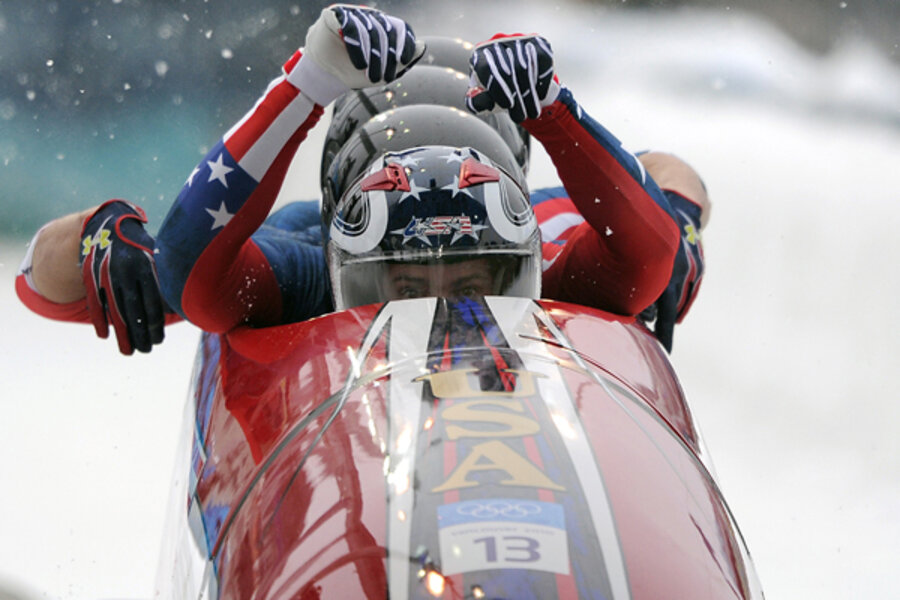Were Vancouver Olympics courses too hard? How fast is too fast?
Loading...
| Whistler and Vancouver, British Columbia
The Olympics are all about going faster and reaching higher. But at the 2010 Vancouver Olympics, some are questioning just how much faster athletes can – or should – go.
From Nodar Kumaritashvili’s fatal crash on the day of the opening ceremonies, to a women’s downhill course that took out 2006 bronze medalist Anja Paerson, to some of the world’s top-ranked bobsled teams careening over the finish line upside down – it’s clear these Olympic courses are testing the limits of more than a few competitors.
They also aren’t a lot of fun, even for the champions.
The day before winning the women’s downhill, gold medalist Lindsey Vonn said she was fighting to make it down the course in training.
“It's not a feel-good course, it's not a fun course, it's a stick-your-nose-in-it-and-make-it-down course,” said Vonn. “If you're skiing aggressive and not sliding, you'll be fast."
The debate highlights a chasm between those who believe the Olympics should be a sort of athletic survival of the fittest, and those who see it as a stage for showcasing not only the abilities but the grace, beauty, and sheer joy the world’s greatest athletes.
“In my mind, we should look for courses that give the joy of skiing,” says Hermod Bjørkestøl, who co-designed the Nordic courses here. It’s no fun to watch skiers laboring up inhuman inclines, he adds – even if they do separate a handful of top athletes from the pack.
But some of the world’s fittest cross-country skiers have taken issue with Bjørkestøl’s courses, with Polish favorite Justyna Kowalczyk saying that they were designed for tourists. She blamed the lack of hills for her failure to medal in the women’s 10 km freestyle, where she finished fifth.
Even at the Pacific Coliseum, a debate over technical prowess versus artistry called into question what kind of performance deserves Olympic gold.
“Quad is quad,” said Yevgeny Plushenko, who got silver despite being the only skater to pull off the jump. His coach Alexey Michin strongly agreed.
“I respect winners,” he said, but then advocated for making skating standards progressively more challenging. “The slogan of the Olympic Games is citius, altius, fortius – it’s what we should do. It’s progress.
Why Plushenko ended up awarding himself 'platinum.'
The luge lesson
The debate has been especially heated at the Whistler Sliding Center, where Kumaritashvili’s crash prompted luge officials to shorten the men’s and women’s courses.
“The track is pushing the sport, and I’m not the only one who is saying that; everyone is saying that,” said Hannah Campbell-Pegg, a luger from Australia who had compared luge athletes to lemmings before Kumaritashvili’s crash. “It’s a shame that something like this had to happen in order for them to reevaluate the safety issues in our sport."
The 2014 Olympic sliding track in Sochi, Russia, was rumored to be designed to be even faster than Whistler’s, but some hope the organizers will reconsider after the fatal crash.
“It’s very tragic that happened, but I truly believe everything happens for a reason,” said Regan Lauscher, a veteran slider from Canada. “The [International] Luge Federation needs to evaluate what happened and what needs to be done for change and for the better. Maybe some good can come out of this.”
For some, danger is a central factor
While the bobsledders have fared better, crashes took out a top German women’s team and dashed all hopes of a medal for the USA-2 sled yesterday – and shook up one driver so much that he decided not to compete.
Edwin van Calker of the Netherlands announced on Feb. 24 that he would not compete in the four-man competition – which means none of his crew could compete, either. The Dutch team emphasized that it was a personal decision and that they believed the track was safe.
“This is a personal decision on Edwin’s part,” said head coach Tom de la Hunty, “from a buildup of numerous factors, including his crash in two-man bobsleigh, the tragic accident in men’s luge, and external family pressures, all of which resulted in Edwin not having confidence in piloting.”
Other athletes though seem to accept that danger is an inevitable part of their sport, and even suggest that is part of the thrill of it – highlighting the huge adrenaline factor that distinguishes many of the winter sports from Summer Olympic events.
Read why lugers were unhappy after new safety measures at Whistler.
“You don’t bobsled to wear seatbelts,” said USA-3 bobsledder Nick Cunningham after his first two runs Friday. “All we’re wearing is a spandex suit and a helmet.”
“Every time you go through [curve] 11, you hold your breath a little,” said USA-1 brakeman Curt Tomasevicz, who said that without that sense of fear it wouldn’t be such a rush.
Numerous athletes also suggested that the crashes are part of what makes the somewhat obscure sport exciting for spectators.
“Fans, as much as they don’t want to say it, like to see crashes,” said Cunningham. “It doesn’t have to get too much harder, but you got to keep reeling in the crowd.”
Brie Schaaf, who finished fifth behind US bronze medalists Erin Pac and Elana Meyers in the women’s competition, also pointed out that organizers such as the ones in Sochi are under pressure to create a competition where higher speeds will be clocked.
“Everyone is always wanting to break records – that’s what gets media attention,” she said. “But you need to get sleds down the track or you don’t have a race.”
Follow Christa's updates on Twitter, and look for her stories on Facebook.





